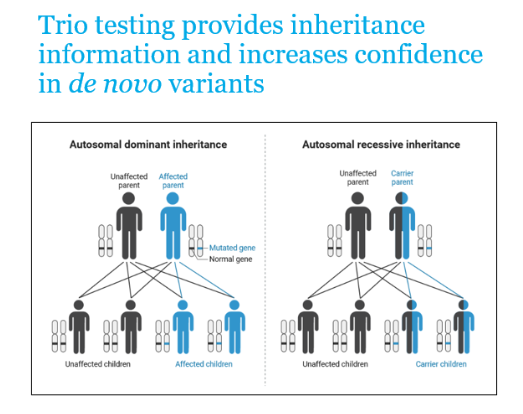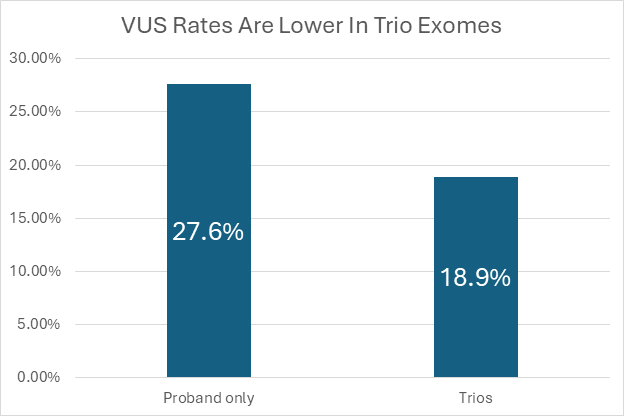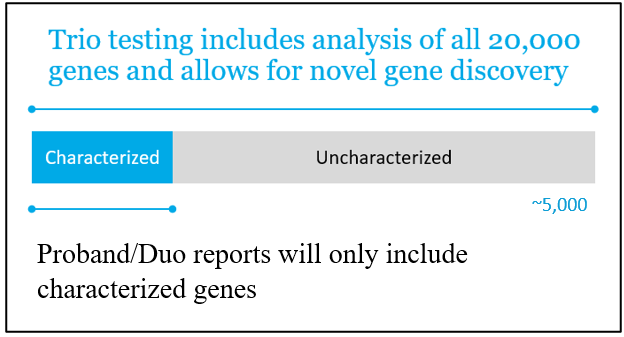Exome sequencing, which assesses the protein coding sections of all ~20,000 genes, is an effective genetic test for a variety of clinical indications, but especially for children with neurodevelopmental disorders. Because the testing range is so broad, it is important to have as much supportive evidence as possible to efficiently identify clinically relevant variants. One of the most effective sources of data is inheritance information—how genetic variants are passed down in a family. We can gather this information through the inclusion of biological family members in exome analysis. First-degree relatives, especially biological parents, are the most informative. Several studies have shown that running an exome “trio” with both biological parents increases the diagnostic yield and decreases the rates of variants of uncertain findings.
Ordering testing on family members of your patient isn’t always intuitive. When else in medicine do we need mom or dad’s sample to clarify a result in a patient? It’s also not always easy, especially if one parent is not present at a clinic visit. However, data clearly shows that running exomes as a parental trio enhances the accuracy and clinical utility of the results.
Exome sequencing can be ordered with or without the inclusion of samples from biological relatives:
• Proband only: testing evaluates the child without any other relatives
• Duo: testing evaluates the child plus one biological parent
• Trio: testing evaluates the child plus both biological parents
Parents may not always be available, and in those cases, other first-degree or second-degree relatives can be informative. Contact your clinical resource at Ambry to find out which available family member may be most informative.
Here are some of the reasons why parental trios are best when ordering an exome:
1. Trio Testing Provides Critical Information about How Variants Were Inherited (or Not).

We all carry genetic variants. Most are not related to health issues, and many are rare but shared with our family members. Having parental exome data to compare to a patient’s data helps us understand which variants are shared among affected and unaffected members of a family and which may be unique (de novo) to a patient.
Distinguishing Inherited vs. De Novo Variants: Comparing the child's exome with the parents' exomes helps determine whether genetic variants were inherited or arose de novo (new mutations). If a patient has a de novo variant in a gene associated with their clinical presentation, it can provide very strong evidence that the variant is causative. Without having parental sequencing information and inheritance information, this line of evidence cannot be determined in any other way.
Understanding Inheritance Patterns: Trio analysis reveals whether a variant is inherited in a manner that matches the inheritance pattern for that disorder. For example, in recessive disorders, inheritance information can confirm whether two variants were inherited in trans (one from each parent). This information is critical for understanding not only the relevance of the variance, but also for recurrence risk predictions for family members.
2. Trio Testing Lowers the Rate of VUS Results.

When we have parental trio data, genetic testing analysts have inheritance data at their fingertips when assessing variants. Especially in rare diseases, where each variant may only be seen in one or a handful of individuals, having access to as much evidence as possible is crucial.
Clarifying Variant Interpretation: Without parental data, it can be more challenging to decide which variants are significant. When there isn’t enough evidence to classify a variant as pathogenic or benign, the result is a variant of uncertain significance (VUS). Applying parental data helps filter out inherited variants that are less likely to cause disease. For example, if a variant is present both in the child and in an unaffected parent, it is not likely to be disease-causing and can more confidently be categorized as benign. In one large study from Rehm et al. (2023), parental trio tests had nearly 9% lower rates of VUS compared to exomes run without both parents.
Improving diagnostic rates: In addition to lowering VUS rates, parental trios can also increase diagnostic rates on exome by providing the needed evidence to classify a variant as likely pathogenic or pathogenic.
3. Trio Testing Allows the Evaluation of Candidate Genes.

Facilitating New Genetic Discovery: The human genome contains about 20,000 total genes. Today, we understand how genetic changes in ~25% of those genes cause disease. When exome testing is performed as proband only or duo testing, the laboratory evaluation and interpretation is limited to only those genes with known disease relationships. However, when parental trio testing is performed, the addition of inheritance data from parental trios allows our team of analysts to more efficiently evaluate candidate genes, where a gene-disease association may be suspected but the relationship is not yet conclusive. Analysis and reporting of candidate genes can lead to the characterizations of new gene-disease relationships through research collaborations (like those we facilitate through GeneMatcher).
Importantly, when a new disease relationship is defined, all exomes—whether they were initially run as a singleton, duo, or trio, are reanalyzed as part of our Patient for Life(TM) program. Proactive reclassification reports are issued for clinically relevant variants, expanding the diagnostic power of all exomes.
While the benefits are clear, parental trio testing is not always possible. Challenges, such as adoption, use of donors when conceiving, death, availability to take time off work, and family dynamics, limit the collection of parental trios and restrict the available evidence for variant classification. Laboratories can address some of these issues by offering at-home collection kits and free family studies following result return to reduce barriers of family member participation.



